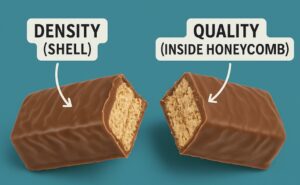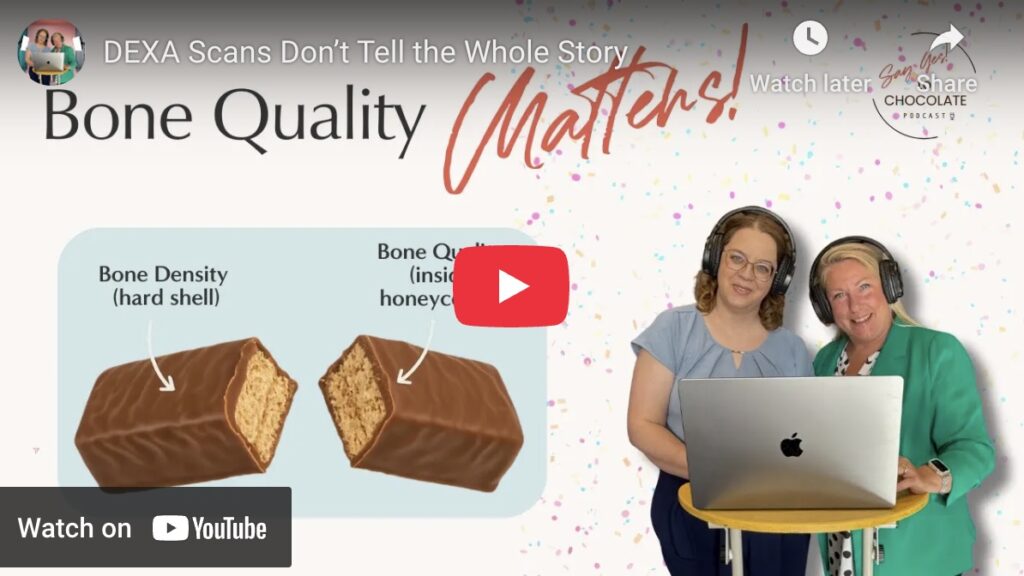Bone Density vs. Bone Quality: What Your DEXA Scan Isn’t Telling You
Most of us don’t think about our bones until something goes wrong. But bone health is about so much more than a number on your DEXA scan.
In this post (and episode of Say Yes! to Chocolate), we’re unpacking the difference between bone density and bone quality, why both matter, and how they work together to determine your true bone strength.
If you’ve ever wondered whether your bone scan results tell the whole story—or how to take action before a fracture happens—this one’s for you.
🎧 Listen to the full episode:
🎥 Watch the full episode:
Why Bone Density Is Only Half the Story
When your doctor talks about bone health, the focus is usually on bone density. A DEXA scan measures your T-score and tells you whether your bones fall into “normal,” “osteopenia,” or “osteoporosis.”
But here’s the catch: bone density is just the outside shell of the story.
True bone strength isn’t just about how dense your bones are—it’s also about how flexible and resilient they are on the inside. That’s where bone quality comes in.
Cortical vs. Trabecular Bone (Think: Candy Bar!)
Here’s a simple analogy:
- The cortical bone is like the hard chocolate shell of a candy bar.
- The trabecular bone is like the honeycomb or wafer inside.

Both matter. Strong bones require a dense shell and a healthy, elastic matrix inside.
If your bones are dense but brittle, they can still break from something as simple as a sneeze or a stumble. That’s why bone quality is critical for fracture prevention.
Everyday Risks You Might Not Realize
Did you know fractures don’t just happen from major falls?
For people with compromised bone health, even daily life movements—like bending to pick something up, sneezing, or catching yourself after tripping—can cause breaks.
That’s why understanding bone quality is just as important as measuring bone density.
How Do We Measure Bone Quality?
While a DEXA scan only measures density, bone quality can be evaluated through:
- Bone turnover markers in blood tests → These show how well your body is building new bone and clearing old bone.
- Emerging technologies like REMS ultrasound scans (more on this in next week’s episode!).
Combining these with your DEXA scan gives you a fuller picture of bone strength.
Taking Action for Stronger Bones
Here are a few places to start if your DEXA scan or bone markers raise concerns:
- Movement that builds bone strength (it takes more than walking!)
- Bone-supporting nutrients like calcium, vitamin D, vitamin K2, and protein
- Lab work to understand your bone turnover rate
👉 Remember: a low score doesn’t mean panic—it means information. And with information, you can take action.
The Say Yes! Takeaway
Don’t settle for half the story when it comes to your health. Bone density matters—but bone quality is just as important. Together, they give you a roadmap for keeping your bones strong, resilient, and fracture-resistant for life.
Episode Show Notes + Timestamps
00:00 Welcome to Say Yes to Chocolate
00:53 Understanding Bone Health
02:22 Bone Density vs. Bone Quality
03:21 Everyday Risks and Fracture Prevention
05:00 Anatomy of Bones: Cortical and Trabecular
08:46 Bone Health Markers and Scans
10:58 Taking Action for Better Bone Health
12:59 Conclusion and Next Steps
✨ Want more simple, sustainable wellness tips?
Join our Email List for weekly wellness strategies you’ll actually look forward to.

+ show Comments
- Hide Comments
add a comment